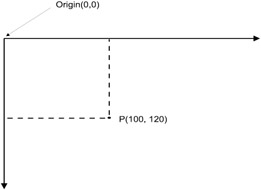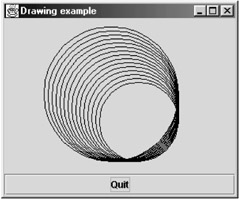14.7 Drawing Simple Objects
14.7 Drawing Simple Objects
The coordinate system used in drawing objects places the origin of the drawing area in its upper-left corner. Figure 14.11 shows the coordinate system to represent the position of a point in the drawing area of the container.

Figure 14.11: Position of a point in the drawing area.
All measures involved in drawing use pixels as the basic unit. The position of a visible dot is measured in the number of pixels to the right of the origin and the number of pixels below the origin. This gives the position using the coordinates (x, y).
This section presents some simple tools and techniques for drawing graphics objects. The tools are provided by predefined classes in the AWT package.
14.7.1 General Functions for Drawing
The general technique for drawing graphics objects is to define a class that inherits class JComponent and redefine function paint. An object is created, and its reference can then be added to a frame.
Function paint is invoked automatically, so there is no need to explicitly call this function. Function paint is defined with one parameter, an object reference of class Graphics, which is a class in the AWT package. The functions for drawing lines, circles, polygons, and so on, are features of the parameter of class Graphics.
To draw a line on the drawing area, from point P1(20, 45) to point P2(75, 50), function drawLine is invoked with the coordinates of the two points as arguments. The following statement draws a line from point P1 to point P2, using the object reference, graph_obj, of class Graphics.
call drawLine of graph_obj using 20, 45, 75, 50
This and other drawing statements must appear in function paint. The following statement draws a rectangle whose upper-left corner is located at point (80, 75), and with 50 pixels for width and 100 pixels for height.
call drawRect of graph_obj using 80, 75, 50, 100
The following statements draw an arc. The arc is part of an oval that is specified by an enclosing rectangle with the upper-left corner located in (x, y), and the size given by width and height. The portion of the arc to draw is specified by the starting angle and the final angle (in degrees).
int x = 20 int y = 50 width = 35 height = 25 startang = 0 finalang = 45 ... call drawArc of graph_obj using x, y, width, height, startang, finalang
Other drawing functions defined in class Graphics are listed in Table 14.2.
| drawOval | Draws the outline of an oval |
| draw2DRect | Draws a highlighted outline of a rectangle |
| drawPolygon | Draws a closed polygon |
| drawRoundRect | Draws a round-cornered rectangle |
| fillArc | Fills a portion of an oval with color |
| fillOval | Fills an oval with color |
| fillPolygon | Fills a polygon with color |
| fillRect | Fills a rectangle with color |
| fillRoundRect | Fills a round-cornered rectangle with color |
| fill3Drect | Fills a rectangle with color |
14.7.2 A GUI with Circles
This section presents an example program that shows two components on a frame: a drawing area with several circles of different sizes and a button with a listener. The program consists of several classes.
Class DrawExample is the main class of the application. It creates a frame with border layout manager for placing the two components. The first component is the drawing area with several circles drawn; an object of class MydrawE is created and placed in the center position of the frame. The button is placed in the south position. The KJP code that implements class DrawExample is shown as follows.
import all java.awt import all javax.swing description This is the main class that presents an example of drawing simple objects. */ class DrawExample is public description The main function. */ function main is constants integer WIDTH = 300 integer HEIGHT = 250 objects object dframe of class JFrame object cpane of class Container // object for drawing area object mdrawing of class MydrawE // button object quitbutt of class JButton object butthandler of class Bquithandler object bordermanager of class BorderLayout begin create dframe of class JFrame using "Drawing example" set cpane = call getContentPane of dframe create mdrawing of class MydrawE create quitbutt of class JButton using "Quit" create bordermanager of class BorderLayout call setLayout of cpane using bordermanager create butthandler of class Bquithandler call add of cpane using mdrawing, BorderLayout.CENTER call add of cpane using quitbutt, BorderLayout.SOUTH // register the listener object with the // button object call addActionListener of quitbutt using butthandler call setSize of dframe using WIDTH, HEIGHT call setVisible of dframe using true endfun main endclass DrawExample
Class MydrawE inherits class JComponent, and the relevant function is paint. This function draws 15 circles of different sizes and at different locations. The KJP code for class MydrawE is listed as follows.
import all java.awt import all javax.swing description This class draws several ovals. */ class MydrawE inherits JComponent is public description Paint where the actual drawings are. */ function paint parameters object gobj of class Graphics is constants integer TIMES = 15 // number of circles variables // position in drawing area integer x integer y // width and height integer w integer h integer j // loop counter begin set x = 50 set y = 20 set w = 170 set h = 170 set j = 0 for j = 0 to TIMES - 1 do // draw a circle call drawOval of gobj using x, y, w, h add 5 to x add 5 to y subtract 5 from w subtract 5 from h endfor endfun paint endclass MydrawE
Figure 14.12 shows the top part of the frame that contains the drawing area with several circles of different sizes and the bottom part of the frame that contains a single button for exiting the program when the user clicks it.

Figure 14.12: A frame with drawing area and button.
| On the CD | The KJP code that implement classes DrawExample and MydrawE are stored in the files |
Another way to organize the program is to define a single class that inherits class JFrame and include a constructor, function main, and function paint. This is a single-class application.
EAN: 2147483647
Pages: 184